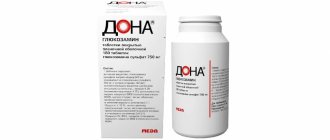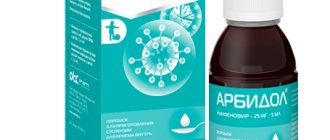Buy Maxicold Rhino powder for preparing a solution for oral administration Raspberry 15g No. 10 in pharmacies
Instructions for use Maxicold Buy at the pharmacy Maxicold Rino por. d/r-ra internal Raspberry 15g No. 10 Dosage forms powder for injection. oral solution raspberry 15g
Synonyms GrippoFlu for colds and flu GrippoFlu Extra for colds and flu Stopgripan Stopgripan forte TeraFlu for flu and colds Group Combinations of paracetamol and adrenergic stimulants International nonproprietary name Paracetamol + Phenylephrine + Pheniramine + Ascorbic acid Composition Active substances: paracetamol 325 mg, pheniramine maleate 20 mg, phenylephrine hydrochloride 10 mg, ascorbic acid 50 mg. Manufacturers Pharmstandard-Leksredstva OJSC (Russia) Pharmacological action A combined drug that has antipyretic, vasoconstrictor, analgesic and antiallergic effects. Paracetamol has an antipyretic and analgesic effect: it reduces the pain syndrome observed with “colds” - sore throat, headache, muscle and joint pain, and reduces high fever. Pheniramine has an antiallergic effect: eliminates swelling and hyperemia of the mucous membranes of the nasal cavity, nasopharynx and paranasal sinuses, reduces runny nose and lacrimation. Phenylephrine has a vasoconstrictor effect: it reduces swelling of the nasopharyngeal mucosa. Ascorbic acid (vitamin C) replenishes the increased need for vitamin C during colds and flu, especially in the initial stages of the disease; increases the body's resistance to infectious diseases. The combined action of pheniramine and phenylephrine leads to a reduction in nasal congestion and a significant improvement in nasal breathing. Side effects Possible allergic reactions, drowsiness, nausea, epigastric pain, dry mouth, accommodation paresis, increased excitability, dizziness, increased blood pressure, difficulty falling asleep, urinary retention, rarely: anemia. Indications for use Symptomatic treatment of “colds”, ARVI, flu, accompanied by high fever, chills, headache, runny nose, pain in the sinuses and throat, nasal congestion, sneezing and pain in muscles and joints. Contraindications Hypersensitivity to individual components of the drug, severe liver/renal failure, pregnancy, breastfeeding, children (up to 12 years). Prescribe with caution for: arterial hypertension, diabetes mellitus, closed-angle glaucoma, liver or kidney diseases, prostate hyperplasia, glucose-6-phosphate dehydrogenase deficiency. Directions for use and dosage : Dissolve the contents of one packet in 1 glass of boiled hot water. Serve hot. You can add sugar to taste. A repeat dose can be taken every 4 hours (no more than 3 doses in 24 hours). The drug can be used at any time of the day, but the best effect comes from taking the drug before bed, at night. If there is no relief of symptoms within 3 days after starting to take the drug, you should consult a doctor. Overdose Symptoms: nausea, vomiting, pain in the epigastric region; hepatotoxic and nephrotoxic effects; in severe cases, liver failure, encephalopathy and coma develop. Treatment: you should do a gastric lavage, take activated charcoal and consult a doctor. Interaction It is recommended to refrain from taking the drug when taking monoamine oxidase inhibitors. The risk of hepatotoxic action of paracetamol increases with the simultaneous administration of barbiturates, diphenine, carbamazepine, rifampicin, zidovudine and other inducers of microsomal liver enzymes. Antidepressants, antiparkinsonian and antipsychotic drugs, phenothiazine derivatives increase the risk of developing urinary retention, dry mouth, and constipation. Reduces the hypotensive effect of guanethidine, which in turn enhances the alpha-adrenergic stimulating activity of phenylephrine. Special instructions To avoid toxic liver damage, paracetamol should not be combined with alcoholic beverages, or taken by persons prone to chronic alcohol consumption. The risk of developing liver damage increases in patients with alcoholic hepatosis. If the drug is taken by patients suffering from diabetes or on a low-sugar diet, it should be taken into account that each sachet contains 13 g of sugar, which corresponds to 1.0 XE. During treatment, it is not recommended to drive a car or other machinery that requires concentration and high speed of psychomotor reactions. Do not use the drug from damaged sachets. Storage conditions Store out of reach of children, in a dry place, protected from light, at a temperature not exceeding 30 C.
Description of the drug MAXICOLD® RINO (MAXICOLD RINO)
Paracetamol
Enhances the effects of MAO inhibitors, sedatives, ethanol.
The risk of hepatotoxic action of paracetamol increases with simultaneous use of barbiturates, phenytoin, phenobarbital, carbamazepine, rifampicin, isoniazid, zidovudine and other inducers of microsomal liver enzymes.
With long-term regular use of paracetamol, the anticoagulant effect of warfarin and other coumarins may be enhanced, and the risk of bleeding increases. A single use of paracetamol does not have a significant effect.
Metoclopramide increases the rate of absorption of paracetamol and reduces the time to reach its Cmax in the blood plasma. Likewise, domperidone may increase the rate of absorption of paracetamol.
Paracetamol may lead to an increase in T1/2 of chloramphenicol.
Paracetamol can reduce the bioavailability of lamotrigine, which may reduce the effectiveness of lamotrigine due to the induction of its metabolism in the liver.
Absorption of paracetamol may be reduced when used concomitantly with cholestyramine, but the reduction in absorption is not significant if cholestyramine is taken one hour later.
Regular use of paracetamol concomitantly with zidovudine may cause neutropenia and increase the risk of liver damage.
Probenecid affects the metabolism of paracetamol. In patients concomitantly using probenecid, the dose of paracetamol should be reduced.
The hepatotoxicity of paracetamol increases with prolonged excessive consumption of ethanol (alcohol).
Paracetamol may interfere with the results of the uric acid test using the phosphotungstate precipitating reagent.
Pheniramine
The effect of other substances on the central nervous system (for example, MAO inhibitors, tricyclic antidepressants, alcohol, antiparkinsonian drugs, barbiturates, tranquilizers and narcotic drugs) may be enhanced. Pheniramine may inhibit the action of anticoagulants.
Phenylephrine
Phenylephrine can potentiate the effect of MAO inhibitors and cause a hypertensive crisis.
Concomitant use of phenylephrine with other sympathomimetic drugs or tricyclic antidepressants (eg, amitriptyline) may lead to an increased risk of adverse cardiovascular reactions.
Phenylephrine may reduce the effectiveness of beta blockers and other antihypertensive drugs (eg, debrisoquine, guanethidine, reserpine, methyldopa). There may be an increased risk of hypertension and other cardiovascular side effects.
Concomitant use of phenylephrine with digoxin and cardiac glycosides may increase the risk of cardiac arrhythmias or myocardial infarction.
Concomitant use of phenylephrine with ergot alkaloids (ergotamine and methysergide) may increase the risk of ergotism.
When used simultaneously with barbiturates and primidone, the excretion of ascorbic acid in the urine increases.
Ascorbic acid
With simultaneous use of oral contraceptives, the concentration of ascorbic acid in the blood plasma decreases. It is possible to increase the concentration of ethinyl estradiol in the blood plasma when used simultaneously as part of oral contraceptives.
When used simultaneously with iron supplements, ascorbic acid, due to its restorative properties, converts ferric iron into divalent iron, which helps improve its absorption.
When used simultaneously with warfarin, the effects of warfarin may be reduced.
When used concomitantly, ascorbic acid increases iron excretion in patients receiving deferoxamine.
When used simultaneously with tetracycline, the excretion of ascorbic acid in the urine increases.
Maxicold for children
MAXICOLD® FOR CHILDREN - a reliable remedy for fever and pain for children from 3 months
Advantages of the drug/molecule
- has a complex therapeutic effect: antipyretic (reduces temperature, relieves heat and fever)
- pain reliever (helps with various types of pain, including teething pain)
- anti-inflammatory (reduces swelling and redness)
Advantages of the release form
- Each bottle is equipped with a polyethylene cap with control of the first opening;
- the convenience of the liquid dosage form and the optimal consistency of the suspension provide parents with comfortable use of the drug and ease of swallowing for children;
- convenience and ease of administration – children’s favorite flavors (orange and strawberry) significantly reduce the risk of negative emotions during the treatment process and make taking the drug pleasant for children and simple for parents;
- simple calculation of dosage depending on body weight - a table for selecting the optimal dose and required volume of suspension depending on the child’s weight is presented on the side surface of the package;
- convenience and accuracy of dosing - the drug packaging is equipped with a convenient double-sided measuring spoon, for 2.5 and 5 ml, respectively;
- the large volume of the bottle – 200 g – provides a sufficient volume of medicine for the full course of treatment, and is also optimal for families with frequently ill children or families with several children
Indications for use
used in children from 3 months to 12 years of age as:
- antipyretic for: acute respiratory viral diseases, including influenza
- acute bacterial infections (tonsillitis, sore throat, pneumonia, etc.)
- childhood infections (measles, scarlet fever, chicken pox, etc.)
- post-vaccination reactions
- other infectious and inflammatory diseases accompanied by high fever
- headache
The drug is intended for symptomatic therapy, reducing pain and inflammation at the time of use; does not affect the progression of the disease.

